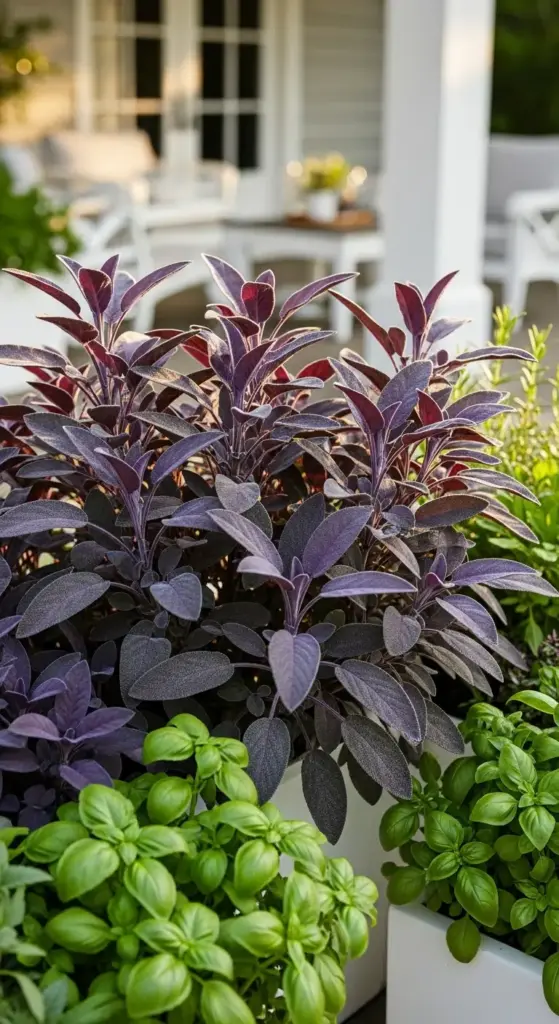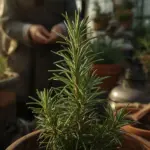7. Sage: The Silver-Leafed Status Symbol

I still get compliments on the “expensive landscaping” on my porch, and honestly? It’s mostly thanks to one perfectly placed sage plant that cost me eight dollars.
That silvery-gray foliage has this magical ability to make everything around it look more sophisticated and intentional – like adding a designer handbag to a simple outfit.
Why Sage’s Foliage Screams Instant Sophistication
Here’s what nobody tells you about sage – it’s basically nature’s version of expensive home decor that happens to be edible.
Those velvety, silver-green leaves create this incredible textural contrast that makes other plants look more vibrant by comparison. It’s like having a neutral backdrop that makes everything else pop.
I learned this when I added one common sage plant to my colorful herb collection. Suddenly, my bright green basil and deep purple oregano looked intentional and curated instead of just “random herbs in pots.”
The sophisticated color palette is unmatched in the herb world. That dusty, silvery-gray tone is the same color you see in expensive interior design – it’s calming, elegant, and timeless.
The texture factor is incredible too. Those fuzzy leaves catch light differently throughout the day, creating this subtle shimmer that looks almost metallic in certain lighting.
Color and Texture Varieties That Stop Traffic
After growing probably six different sage varieties, I’ve learned which ones pack the biggest visual punch for container displays.
Purple sage (Salvia officinalis ‘Purpurascens’) is my absolute showstopper. Those deep burgundy-purple leaves with silver undertones? Pure luxury. I planted one in a simple white ceramic pot and people literally stop to ask what that gorgeous plant is.
Tricolor sage brings this incredible variegated effect – green, cream, and pink all in the same leaf. It looks like someone hand-painted each leaf individually. Perfect for adding that “expensive ornamental plant” vibe to herb collections.
My design game-changer discovery? Silver sage varieties like ‘Berggarten’ with those broad, almost white leaves that look like living sculpture.
I learned to combine all three varieties in one large container. The color variation creates this sophisticated tapestry that looks like a professional designer planned it, but it’s just three different sage plants playing well together.
Golden sage deserves mention too – those chartreuse-yellow leaves add brightness while maintaining that sophisticated sage texture and form.
Designing with Sage as Your Anchor Plant
This is where I learned to think like those fancy landscape designers who charge thousands for herb garden installations.
Sage works perfectly as a focal point because of its substantial size and distinctive color. I use it as my “thriller” plant – the one that draws the eye and anchors the whole arrangement.
The key is proper placement. I position sage slightly off-center in large containers, then build around it with complementary herbs. Creates visual interest without looking too symmetrical and planned.
Height layering is crucial when using sage as a focal point. I surround it with medium-height herbs like oregano and thyme, then add trailing varieties around the edges.
I discovered that sage’s silvery color makes other colors more vibrant. Purple basil looks more purple, green herbs look more green – it’s like having a natural color enhancer in your arrangement.
Pro design tip: Use sage to create visual bridges between different container groupings. The consistent silver color ties separate pots together into one cohesive display.
Year-Round Beauty That Never Disappoints
Here’s what I love most about sage – it looks good 365 days a year while other herbs are taking seasonal breaks.
Even in winter, those silvery leaves provide structure and interest when everything else has died back or gone dormant. It’s like having a living sculpture that changes subtly with the seasons.
Spring brings fresh new growth with that incredible soft, fuzzy texture on young leaves. The contrast between new silver growth and older, more established foliage creates beautiful depth.
Summer is when sage really shines – those flower spikes in purple, blue, or white add vertical interest and attract beneficial insects. But even without flowers, the foliage alone carries the show.
I learned that fall actually enhances sage’s beauty. Cooler temperatures intensify the silver coloring, and the plant maintains its shape and fullness when other herbs start looking tired.
Winter interest is unmatched among herbs. While basil and oregano disappear, sage stands there looking dignified and intentional, providing structure to your winter porch display.
Spacing and Companion Planting Secrets
This is where I learned the difference between cramming plants together and creating sophisticated, professional-looking arrangements.
Sage needs room to breathe. I give each plant at least 12-18 inches of space to develop that beautiful, mounded shape. Crowding creates leggy, unhappy plants that look cheap instead of elegant.
The magic happens in the companion choices. Lavender and sage together create this incredible Mediterranean sophistication – both have similar silvery tones but different textures and forms.
Dark-leafed herbs like purple basil or chocolate mint create stunning contrast against sage’s silver foliage. The color combination looks intentional and expensive.
I discovered that fine-textured herbs like thyme work beautifully planted around sage’s base. Creates layered interest without competing for attention.
Avoid pairing sage with other silver plants in the same container – it gets monotonous. Instead, use sage as your silver element and choose companions in greens, purples, or golds.
Complete Investment Guide Under $50
Here’s exactly what I spent on my most successful sage-centered display:
Sophisticated Mixed Container:
- Purple sage plant: $8
- Tricolor sage plant: $9
- Large decorative container (16-inch): $18
- Premium herb potting mix: $8
- Decorative mulch (white stones): $5
- Total: $48 for a designer-quality arrangement
Budget-Friendly Sage Garden:
- Common sage plant: $6
- Two complementary herbs (thyme, oregano): $8
- Repurposed wooden planter: $8
- Basic potting soil: $6
- Total: $28 for elegant simplicity
My biggest money-saving discovery? Sage is incredibly long-lived compared to other herbs. One plant can thrive for 3-4 years in the same container with proper care.
Propagation is surprisingly easy – sage roots well from cuttings taken in early summer. I’ve multiplied my collection by taking 4-inch stem cuttings and rooting them in water.
Division works too for established plants. In spring, carefully separate root clumps to create new plants. Each division becomes a full-sized sage plant within one growing season.
Thrift store container hunting yielded amazing finds for sage displays. Old ceramic bowls, vintage planters, even repurposed kitchen items work perfectly and add character.
End-of-season sales are where I score specialty sage varieties. I’ve found purple and tricolor sage marked down to $3-4 each in late summer clearances.
Pro budget tip: Start with common sage for the biggest impact per dollar. You can always add specialty varieties as your collection and budget grow.
The ongoing value is incredible – fresh sage for cooking (especially amazing with roasted vegetables), natural pest deterrent, and that constant sophisticated presence that elevates your entire herb collection.
Plus, sage is practically maintenance-free once established. Drought-tolerant, deer-resistant, and actually prefers benign neglect – perfect for creating that effortless luxury garden vibe.
Bonus value: Sage flowers are edible and gorgeous as garnishes, so you’re getting culinary and ornamental benefits from the same plant.
Conclusion
There you have it – seven herb planter ideas that prove you don’t need a millionaire’s budget to create a millionaire’s garden!
Each of these herbs not only adds incredible flavor to your cooking but transforms your porch into a sophisticated outdoor retreat that your friends will envy.
The beauty of these herb gardens lies in their dual purpose: they’re both functional and fabulous.
You’re not just growing plants; you’re creating an experience, a lifestyle upgrade that pays dividends every time you step outside or cook a meal.
Ready to start your millionaire herb garden journey?
Pick one or two herbs that speak to you most, grab some budget-friendly containers, and watch your porch transform into the elegant space you’ve always dreamed of. Your future self (and your dinner guests) will thank you!








GIPHY App Key not set. Please check settings